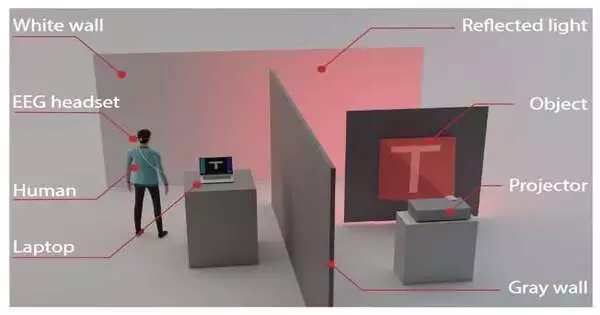Thanks to researchers and businesspeople who have been attempting to tap into the potential of brain-computer interfaces for enhanced cognitive abilities, interacting with computers by brain activity seems less far-fetched today.
Recently, researchers at the University of Glasgow, Gao Wang, and Daniele Faccio showed that it is possible to perform basic computational imaging tasks by connecting a human brain and a computer. Similar developments may one day increase the sensing capacity of human vision and open up fresh perspectives on the neurophysics of human perception. Intelligent Computing published the results of this study.
Wang and Faccio computationally reconstructed images of an object hidden behind a wall using ghost imaging. The detection of corresponding light intensity values and the use of various illumination patterns are the foundations of ghost imaging.
“A initial impression may be that the visual system is just serving as a different type of camera,”
Gao Wang and Daniele Faccio at the University of Glasgow.
The light intensity measurements are typically made by a camera or other similar device, but some researchers have also experimented with using the human visual system as a sensor. The use of the human visual system for both signal detection and real-time feedback in Wang and Faccio’s research sets their work apart from other similar works.
In Wang and Faccio’s experiment, a white secondary surface was used to reflect flickering light patterns onto an object. The participant’s visual cortex sensed the intensity values of the reflected light, and a headset with a single electrode recorded these values as electrical signals. An algorithm created to reconstruct the image of the hidden object then processed the signals on a laptop. According to the authors, “at first glance, it may appear that the visual system is merely acting as a different kind of camera.”.
The authors included an adaptive computational loop to facilitate more effective and higher-resolution imaging. They could “carve” out the less-helpful projected light patterns with the aid of the real-time feedback provided by the human visual system to enhance both imaging speed and image quality.
In contrast, when participants were asked to speak or type on a keyboard while their brain signals were being recorded, the authors discovered in a subsequent experiment that the quality of the reconstructed images was diminished.
The authors of this paper, Wang and Faccio, believe they have laid the groundwork for brain-computer interfaces that would support non-image-based computations. Given the conflict between conscious and non-conscious processing, they also emphasized the need for further research.
The experiments were created by Wang and Faccio, who also wrote the manuscript. Wang carried out the experiments, gathered the data, and conducted the analysis.
More information: Gao Wang et al, Computational Ghost Imaging with the Human Brain, Intelligent Computing (2023). DOI: 10.34133/icomputing.0014





